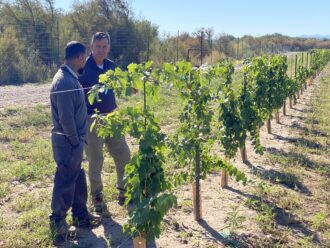Reasons to like wine Number 462: It can be good for New Mexico’s native bees and other pollinators.
Even though grapevines are largely self pollinating and don’t need insects like bees or butterflies to produce fruit, vineyards themselves can provide habitat for native pollinators and other insect species, benefiting both the grower and the environment.
“The idea is to knit together vineyards and native pollinators,” explained Gill Giese, an extension viticulture specialist at New Mexico State University. “These vineyards are a ready resource to integrate into environmental conservation, a nexus between agriculture and conservation. Those don’t have to be antagonistic.”
Giese and Miranda Kersten, New Mexico State University’s Integrated Pest Management Program manager, received a Research to Grassroots grant from Western SARE to discern and document how that connection can be made.
“The grant is designed to promote putting cover crops in vineyards, and specifically, more native plants that can encourage pollinators and other beneficial insect populations,” Kersten said.
The area in vineyards ripe for cover crops are the row middles, areas often cultivated or sprayed with herbicides to be kept clear, or covered by weeds that are periodically mowed down. Cover-cropping those strips can have a plethora of benefits, Giese and Kersten said.
Cover crops help prevent soil erosion in high winds and floods. They keep dust down in the vineyards. They increase soil organic matter and can help with weed management by outcompeting weed species. The can help control nematodes that are often a problem in sandy soils. They reduce soil temperature in the row middles and make for a better working platform for vehicles or workers.
They may also improve the wine itself.
“Some of the recent research is documenting and quantifying the effect of cover crops on the soil microbiome that might be transmitted to the grapes and consequently to the wine,” Giese said. “Also I think wine consumers, by and large, want to see grapes and wine produced in an environmentally sensitive manner.”
With the Western SARE grant, the team planted a cover crop mix in a New Mexico State University research vineyard and three commercial vineyards in the spring but saw all those efforts fail.
“The seeds just didn’t germinate,” Giese said. “These were good growers, too, so we’re pretty sure the mix was not suited to our conditions .”
They switched suppliers and planted two vineyards in southern New Mexico this fall. Those plants benefited from later-than-usual rainfall and were coming up.
“We’re confident it’ll get established now so it’ll thrive over the winter and flower in the spring,” Giese said. “We’ll survey the flowering plants and monitor their progress in the spring and collect data to correlate that with the number and species of pollinators that visit.”
Two potential concerns for growers are water use and cost, but the economics of wine production may help overcome both.
“Grapes use significantly less water than some of our other major crops like alfalfa, pecans or even cotton, so they are looking attractive to growers,” Giese said. “Especially given the high economic potential of wine.”
Whether those economics justify the cost of planting the pollinator-attracting cover crop mix is one element being examined in the research.
“The mix we just planted was $75 a pound, and you apply about 10 pounds per acre,” Kersten said. “That’s pretty pricey. So maybe we’ll identify a few plants from the mix that work well and aren’t as expensive, or maybe we can look at more traditional cover crops and promote those initially and introduce the idea of pollinator habitat as something you build up to.”
One benefit both Kersten and Giese see for growers with the pollinator-attracting mix is the aesthetics of having a colorful, flowering mix of plants in their vineyard rows.
“Most wine growers in the state are self-distributing their wine or they’re selling at a tasting room,” Giese said. “And they know that having an attractive area before visitors get to the tasting room adds to the customer experience. That’s an unquantified aspect of cover crops but I think a valuable one that growers – especially growers hand-selling wine – very much appreciate.”
